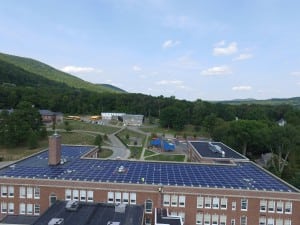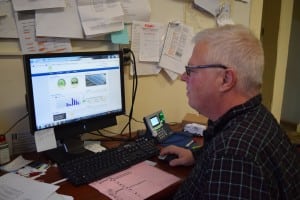Panels will reduce electric bill by $21,000 annually
The Haldane Central School District has entered the era of solar-generated electricity with the completion of a project in partnership with Monolith Solar of Rensselaer, New York. The $852,000 project cost the school district nothing but will substantially reduce its electric bills. Part of the project cost was covered by a grant from the New York State Energy Research and Development Authority (NYSERDA).
A contract between Haldane and Monolith known as a Power Purchase Agreement includes the installation of 958 solar panels on the roofs of the high school, middle and elementary schools, district office and garage. Monolith installed, owns and will maintain the system throughout the 20-year life of the agreement. It makes money by selling the bulk of the electricity generated at Haldane to the national grid, while providing reduced rates for the district.

According to Mike Twardy, Haldane’s director of facilities, the district’s electrical bill was about $85,000 last year. The agreement with Monolith guarantees Haldane at least a 25 percent reduction in the cost of its electricity, or a minimum annual savings to taxpayers of $21,250. The more electricity the system generates, the greater the savings.
Enough electricity for 400 homes
In a presentation to the Haldane School Board on Dec 1, Lindsey McEntire of Monolith said the system will generate up to 349,030-kilowatt hours of electricity annually, or enough power to supply more than 400 homes for a year. On average, the project will generate about 60 percent of Haldane’s electrical needs. During periods when the Monolith system is offline, such as at night, the grid will supply Haldane’s electricity.
Superintendent Diana Bowers said “it was a fun project to work on.” The project was undertaken “to be more ‘green,’ to reduce our carbon footprint, as well as to realize cost savings,” she said. The project also has great potential as an educational tool for students in every grade. “Students will be able to follow this project for years,” she said. While lessons for younger students will focus on the environmental benefits of solar energy, including how it saves trees and reduces emissions, older students will be able to delve into the math, physics and chemistry behind photovoltaics.

Monolith uses the educational potential of its installations as a marketing tool, providing schools with numerous teaching resources. The company has contracted with 16 districts across New York and McEntire said that number will triple within two years.
One resource Monolith provides is a real-time, online monitoring system that tracks the productivity of Haldane’s system. Students, teachers and the public can monitor the high school portion of the system at locusenergy.com by logging in with user name [email protected] and password solar21. Electrical output can be viewed in graph form by the day, week, month and year. Similar websites are also available for the main building and district office components of the system.
Residential applications
The company also installs residential systems and has offered to donate $250 to Haldane’s Science Technology Energy and Math (STEM) Program for each local resident who contracts with Monolith to install solar at home. The residential program gives homeowners the option of purchasing the system. McEntire said that the average “price range for installation is $7,000 to $10,000 and that the typical return on investment is about two years. She also said NYSERDA offers grants to homeowners.
School Board trustees first discussed a solar energy project in 2012. The system was up and running at the district office and garage in July of this year and at the high school a month later. The main building’s system was completed in November.
Solar panels more efficient in winter
Solar panels convert the sun’s energy into direct current. An inverter transforms that power into alternating current, which is fed into the schools’ electrical systems. Bowers commented that one of the interesting and perhaps counterintuitive aspects of the project is that solar electricity is generated more efficiently in winter than in summer, a fact that is confirmed by energymatters.com.
“A popular misconception is that solar panels work best on the hottest days,” the website states. “In fact, it’s quite the opposite. Heat is the enemy of solar panels; it’s just that during summer the days are far longer.”
The site also points out that solar panels function more efficiently in cooler weather. “A blue-sky winter’s day can see some amazing levels of power produced on an hourly basis compared with summer.” The downside of winter solar electric production is the reduced number of daylight hours and the greater number of cloudy days.

It’s great to see the original 1934 school building being transformed for the 21st century. Between the solar project and the recent improvements in building insulation, heating and ventilation, the school has reduced its carbon footprint by close to 50 percent and is saving a lot of money. Although the article says the school’s panels could power more than 400 homes, it’s probably more like 40 to 50 homes.
OK. Can we get community solar power? It’s not feasible for me alone in a small house, as are many in the village. But if we could get a community source – like a reservoir, for electricity – we could all draw on it. Any reason why not?!
Too bad Haldane fell for the PPA is more like it. This is really benefiting no one but contractor, for 20 years. Sure, it’s no money down and a decreased utility bill but… there’s a BUT! We could have done 10 times better for the school and actually gotten them more of their bill decreased, as well. The SREC credits that will ultimately hit New York State soon will be a bounty for Solar PV system’s owner’s (not lessee’s). We could have actually used more panels on more of the campus and proposed a solar farm that would have brought in tens of thousands of dollars per year on top of dramatically lowering their electricity bills.
As well, a $200 commission paid to the “Science Department” for any local homeowner in the Haldane region for yet another person’s roof being put in prison for 20 years from this smacks of something entirely unsunny to me. I’d like for an RFP to have gone out to compete to really teach how solar is dynamite for school districts (and I’ll reach out to Mahopac, Webutuck High School real soon, too). Also, I would help to contribute (as a certified Earth Science teacher recently skewered) to create a K-Solar curriculum with real-world experience and meaningful facts as well as data to teach the new energy industrial revolution of clean and sustainable energy as well as career readiness.
I gladly accept sharing my posts and I would gladly ‘compete’ for business any day. For Haldane it’s a win/lose. When more actually figure out how solar works, there will be some really upset people out there but not from our clientele. X10!
Jack Mosel
VP, Commercial Solar PV
Congratulations to Haldane for its bold move into 2016! I am always so impressed by how they strive not just to succeed, but also to be an example for their students and faculty. Very proud of our district, our school board, and the fact that my children will be able to experience this shift towards renewable energy.
When we were planning this project three years ago, we had one vendor try to convince us that SRECs were right around the corner and if we signed up with them we’d be first in line. Well, as of today, there’s still no sign of SRECs in New York. Perhaps “ultimately” Mr. Mosel will be proven correct, but Haldane has a completed project and is saving money now. The length of the agreement is 10 years.
Thanks to those with foresight who have helped to set the trend!
Bloomberg News: What Just Happened to Solar and Wind is a Really Big Deal
“The clean-energy boom is about to be transformed. In a surprise move, U.S. lawmakers agreed to extend tax credits for solar and wind for another five years. This will give an unprecedented boost to the industry and change the course of deployment in the U.S. The extension will add an extra 20 gigawatts of solar power — more than every panel ever installed in the U.S. prior to 2015, according to Bloomberg New Energy Finance (BNEF). The U.S. was already one of the world’s biggest clean-energy investors. This deal is like adding another America of solar power into the mix.
“The wind credit will contribute another 19 gigawatts over five years. Combined, the extensions will spur more than $73 billion of investment and supply enough electricity to power 8 million U.S. homes, according to BNEF.
” ‘This is massive,’ said Ethan Zindler, head of U.S. policy analysis at BNEF. In the short term, the deal will speed up the shift from fossil fuels more than the global climate deal struck this month in Paris and more than Barack Obama’s Clean Power Plan that regulates coal plants, Zindler said.”
Haldane has really raised the bar! I know its efforts will be contagious and, for example, Garrison will follow suit utilizing the huge south facing roof of the “new” gymnasium.
Our household has just last week come on line with a 3,500-watt solar system that cost us approximate $14,000 before the federal tax credit of 30 percent kicks in. New York State has a strong incentive, as well. We think our payback is around 12 years. Not too shabby. And our carbon footprint will be cut in half. Come on by for a look.
Thank you Haldane for being a solar beacon for our community!
This is a terrific accomplishment. I would, however, rather see the district purchasing panels and owning the electricity which is produced. We bought our panels three years ago and they should pay for themselves in just a short while. Our roof remains our own and all electricity which we produce benefits us at no cost. Our surplus goes to the grid. Leasing our roof was not something we would consider. A reduced electricity bill is a rip-off. We have an electric plant up there. I hope my comments lead other home owners to purchase rather than lease panels.
I would like to add that I applaud Haldane for being pro-active and cutting through to the chase to integrate solar. SREC’s may be 5+ years out for New York State. The $200 commission to “the science department” from any area “leads” generated smacks of kick-back no matter how you slice it. Will those homeowners too be sold a PPA lease, as well, and not be educated as to how these solar lease arrangements are less than honest when they are being sold?
In New York there are NYSERDA-certified installers who educate and go to great lengths as to comply with all due diligence as to ensure New York State grants, Federal ITC refunds and NYSERDA 3 percent loans are offered to own a solar power plant on a resident’s roof. After all is said and done, typically there is a contribution available that can be as much as 60 percent or better to assist in ownership of a solar power system. A dollar-for-dollar real estate value increase too is not assessed on the property but added to the value of a home for owning a solar power plant on a home.
As a solar power turn-key contractor in the area, I do not offer a lease program as I feel it is not beneficial to a homeowner or to the next homeowner who will assume the 20-year lease). I am merely trying to weigh in that there is more to this story.